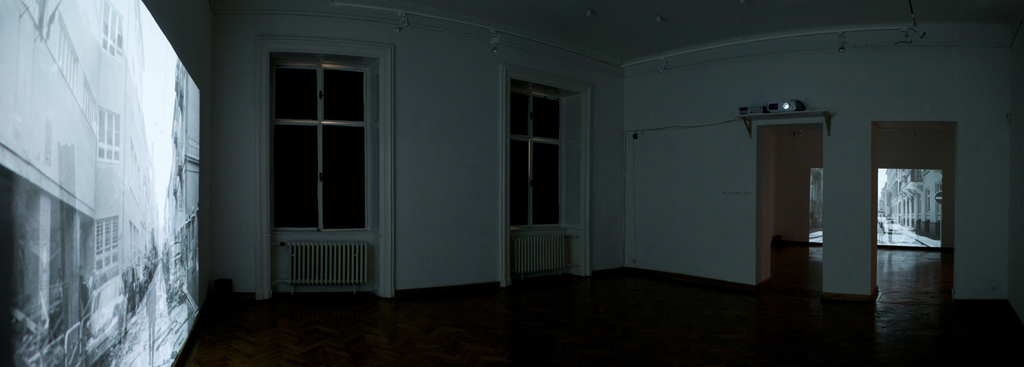3 DATES
3 DATES / 3 DÁTUMY 2013, videoinstalation
Curator: Petra Hanáková
Gallery Medium, Hviezdoslavovo nám.8, Bratislava
26-29.9.2013
KNOW YOUR CITY (Three Dates of Noro Knap)
Particularly in the recent years, Bratislava has become a city of endless activity. Almost every weekend, someone is being crowned, many roller skate or ride push bikes, tasty morsels are savoured, festivities are celebrated, stories are made up about this and that and those who don’t quite know can “BLAF” and look like they do…
Even in the past, Bratislava used to be a city of many celebrations and festivities. Thisfestive potential of the city and its dark undercurrents present the theme of the newly composed project by Noro Knap. The focus of his work is the Slovak State and the moments and the places in the city when/where something mysterious (and is by now deeply engraved) happened.
For the last ten years, the existing Slovak State has been widely represented in visual arts. The archival nature of photography stirs the memory towards the theme of holocaust trauma (for example the recent exhibition The Imprints of Gisi Fleischmann in Pisztory Palace). Other sources of the photographical reflexion is propaganda with its obsessive, mendacious and pathetic formulas. One of the main themes of the contemporary theory of photography relates to the “moral conflict” between Beauty and Truth, aesthetics and ethics of photography. Even though this conflict is not a key focus of this installation, it maintains its subtle presence throughout the artist’s work.
Thanks to the Slovak Press Agency archives (and the recent research by Bohunka Koklesova focusing on the official Slovak State photography), a rich deposit of truly convincing images has been preserved and is being explored. And it is this historical deposit from which Noro Knap selected three iconic images. He identified the original locations of these images and at the same place, on the same day, with similar light conditions and only several decades later, he shot these incriminated places of the city again. In this way, he submerged the historical photographical images in a liquid picture, from which his pictures-films emerged and transcended into the present day. His visual work is interwoven with a plastic soundtrack and shown in a gallery that underpins Knap’s work by its architectural foot print and by its location in the centre of the city.
The result of this composition is a complex work yet one that engages well with the viewer at the same time (Knap concludes each one of his projections by a special film strip, which is a complete sequel of photographs taken during a particular photo shoot. The shots are out of focus and clearly edited (post production), nevertheless they provide us with more profound portrayal of the event (casus) that culminates in a projected image.) Perhaps you can recall the project Assimilation presented in Medium recently with its rather intricate visual accessibility. Contrary to Assimilation, Knap’s installation presents us with a confrontation between a fairly classic production (with a unity between time and space) and a very mainstream artistic ambition. Knap wants - and considers it his duty - for his work to be accessible.
Knap’s project portrays several existing trends in the contemporary art - an interface between photography and archeology, two disciplines that preside over the imprints of the past; a work with archives, with memory and remembering; critical local patriotism and sensitivity for site&time specific art; cinema and outside of cinema - projection of interactive art in a gallery setting.
Tri Datumy (Three dates) presents us with an elegant mediation of existing possibilities - a quasi second life of photography portrayed via new media. Previously, the very different worlds of static and moving image are now merging together with a greater ease; it is more commonplace for the photographer to work with film and vice versa. We now talk about post-photography, post-film photography and about film after film. Noro Knap (characteristically a photographer and a designer by profession) also belongs to this category of post-photography artists. His photographical work expands in time and space and transcends into film or 2D or 3D projects.
Just as the majority of works based on the projected image, Knap’s Tri Datumy (Three Dates) is also devised in a way that the viewer is able to contemplate the different sections of the artist’s work in a relative privacy. The selection of centrally composed images capturing events in a static and to some degree a passive manner, determines the film’s theatrical arrangement. This also reinforces the “immersion” effect of classic “KinoApparatus” and the ability of the film (and the projection) to suture the viewer into their world.
It is as if the viewer should, through a time tunnel, enter or come closer to that historical
punctum temporis of the original snapshot, yet acquire a certain distance via the moving image (film). At the same time, through the triple effect of the projections the viewer should “feel in his/her feet” the spacial pattern of the gallery and the map of the city and understand the events of the past and their resonance with the present.
The slovak-state stratum of the history of our city is becoming ever more a concrete part of our memory and/or remembering. For the last two years, we have been sadly reminded of this stratum by a strangely progressive model of the Synagogue at the near Rybne Namestie. I believe that Noro Knap found an artistically more productive technique that emphasises the problematic past.
His triadic projection Tri Datumy (Three Dates) is a study of historical memory, the archeological potential of photography, the layers of events in the city and, as the author says, the “crime and punishment”…
Knap’s exhibition will most likely be a kind of artistic sermon about morality. Yet, for the time being, is it possible to identify a novel approach in the art arena that would enable us to connect with this rather contemptible chapter of our history in such an engaging way?
Petra Hanakova











